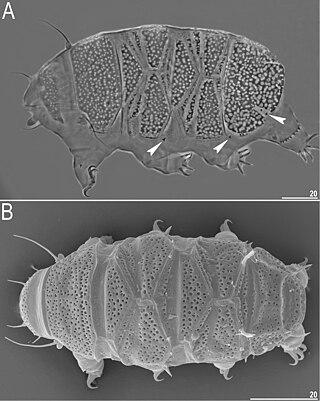
Echiniscus testudo is a cosmopolitan species of tardigrade.

Hypsibius is a genus of tardigrades in the class Eutardigrada.
Diphascon is a genus of water bear or moss piglet, a tardigrade in the class Eutardigrada.
Doryphoribius is a genus of water bear or moss piglet, a tardigrade in the class Eutardigrada.

Ramazzottius is a genus of water bear or moss piglet, a tardigrade in the class Eutardigrada.
Itaquascon is a genus of tardigrade in the class Eutardigrada.

Isohypsibius is a genus of water bear or moss piglet, a tardigrade in the class Eutardigrada. The length of an isohypsibius tardigrade ranges from 0.1 millimeters to 1.5 millimeters. In addition to eating algae and plant cells, tardigrades also consume insect larvae and even other tardigrades. They live in a lot of places, like damp wooded areas with moss, lichens, leaf litter, and dirt. These animals can also be found in natural lakes and ponds.

Milnesium is a genus of tardigrades. It is rather common, being found in a wide variety of habitats across the world. It has a fossil record extending back to the Cretaceous, the oldest species found so far is known from Turonian stage deposits on the east coast of the United States. Milnesiums are one of the most desiccation and radiation-resistant invertebrates on Earth because of their unique ability to transform into a "tun" state and utilize intrinsically disordered proteins when experiencing extreme environments.

The Echiniscidae are a family of tardigrades, a phylum of water-dwelling, eight-legged, segmented micro-animals. It is one of the four families in the order Echiniscoidea. The family was named by Gustav Thulin in 1928.

Echiniscus is a genus of tardigrades in the family Echiniscidae. The genus was named and described by Karl August Sigismund Schultze in 1840.
Pseudechiniscus is a genus of tardigrades in the family Echiniscidae. The genus was named and described by Gustav Thulin in 1911.

Bryodelphax is a genus of tardigrades in the family Echiniscidae. The genus was first described by Gustav Thulin in 1928.
Mopsechiniscus is a genus of terrestrial tardigrades in the family Echiniscidae. It was named and described by Eveline Du Bois-Reymond Marcus in 1944.
Macrobiotidae is a family of tardigrade. As of 2023, it consists of the following genera:
Richtersiidae is a family of tardigrades belonging to the order Parachela.
Bertolanius is a genus of tardigrades belonging to the family Eohypsibiidae.
Calcarobiotus is a genus of tardigrades belonging to the family Macrobiotidae.
Mesobiotus is a genus of tardigrades belonging to the family Macrobiotidae.

On April 11, 2019, the Israeli spacecraft Beresheet crashed into the Moon during a failed landing attempt. Its payload included a few thousand tardigrades. Initial reports suggested they could have survived the crash landing. If any of them did survive, they would be the fourth animal species to reach the surface of the Moon, after humans, brought by the American Apollo program, and fruit flies and silkworms, the latter 2 both brought to the moon by China's Chang'e 4.
We believe the chances of survival for the tardigrades... are extremely high.








